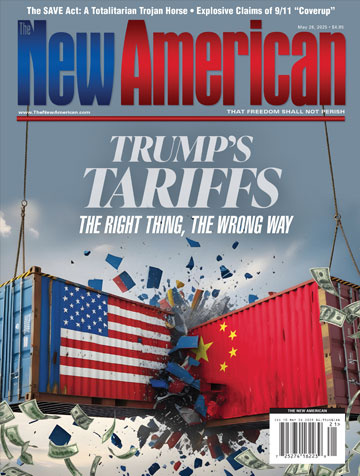
On Friday, April 14, Canadian Pacific Railway and Kansas City Southern officially merged and became Canadian Pacific Kansas City (CPKC), the first freight railway linking the United States, Mexico, and Canada — essentially a USMCA Super Railway. The newly merged company also unveiled a new logo and website. Marking the historic merger, the company homepage said, “Connecting a continent,” describing CPKC as “The first and only single-line rail network connecting North America.”
“Today, we celebrate this historic combination creating a truly unique single-line rail network that begins a new chapter of railroad history in North America,” said CPKC President and CEO Keith Creel. “As we mark this once-in-a-lifetime occasion by driving the Final Spike in Kansas City, Missouri, where CP and KCS come together, we stand ready to bring new competition into the North American rail industry at a time when our supply chains have never needed it more.”
This came a month after federal regulators in the U.S. approved a $31 billion deal by the Canadian-based Canadian Pacific Railway to acquire the formerly U.S.-based Kansas City Southern Railway Company. As Creel explained in his remarks, CPKC “begins a new chapter of railroad history in North America.”
However, the story of the new super railway actually began in 1996, when then-U.S.-based Kansas City Southern and Mexican-based Transportación Maritima Mexicana founded the Transportación Ferroviaria Mexicana (TFM) railroad company in Mexico as a joint venture between the companies. TFM connected ports in Veracruz, on Mexico’s southern Gulf coast, and in Lázaro Cárdenas, on Mexico’s Pacific coast, up through Mexico City and Monterrey in Nuevo Leon, and as far north as Laredo, Texas, on the U.S.-Mexican border.
In 2005, Kansas City Southern acquired the majority shares and ownership of TFM, and renamed it Kansas City Southern de México. This merger extended the connection further north into the United States through Kansas City and as far north as Springfield, Illinois. Most of Mexico’s major auto plants are located along Kansas City Southern de México (KCSM)’s railways, making it a key supply chain within the North American Free Trade Agreement (NAFTA), enabling Mexican-built cars to be easily transported and sold in the United States. At the time, the KCSM was dubbed the “NAFTA Super Railway,” because of how Chinese goods arriving in the port of Lázaro Cárdenas could be transported seamlessly up to Kansas City and Springfield.
Now, as a result of this new merger with Canadian Pacific forming CPKS, the same Chinese goods arriving (and hopefully inspected) in the Mexican port of Lázaro Cárdenas will be easily transported up north through CPKS’s railways in Iowa, Minnesota, North Dakota, Wisconsin, Maine, and into Canada. The merger creates a true North American super railway spanning from Vancouver to Veracruz.
In a 2021 press release, Creel, who was then the president and CEO of Canadian Pacific, credited this integration of North American supply chains to the United States-Mexico-Canada Agreement (USMCA), which replaced NAFTA. This de facto USMCA Super Railway is a major step in the globalist’s plan for a North American Union, as it further integrates a major component of the economies of all three countries along regional lines. Such regional lines result in the erosion of national sovereignty and the individual economic identity of all three countries.
In his last day in office, former Mexican President Enrique Peña Nieto touted how the USMCA will “consolidate the economic integration of North America.” And current Mexican President Andrés Manuel López Obrador has continued to lump additional coal into the same furnace, railroading the continent toward an NAU.
Earlier this year, when U.S. President Joe Biden visited Mexico City to meet with Mexican President López Obrador for the United States-Mexico bilateral meeting of the North American Leaders Summit, López Obrador made a “comprehensive proposal” to Biden to “consolidate [the United States, Mexico, and Canada] as an economic region.” López Obrador proposed a new policy to further the economic and social integration of North America.
“The proposal, President Biden, is comprehensive. It implies consolidating ourselves as an economic region in the world, strengthening brotherhood in the American continent, respecting our differences and our sovereignties, and ensuring that no one is left behind and that together we go in search of the beautiful utopia of freedom, equality and true democracy,” López Obrador told Biden.
To facilitate his proposal, López Obrador called for the creation of a “joint committee … aimed at planning and import substitution in North America, to try to become more and more self-sufficient” as one economic bloc.
“The US, Canada and Mexico will each propose 4 members for the formation of this group of specialists. They will have our absolute confidence to motivate, persuade and convince businessmen, workers and public servants of the importance of uniting in North America and seeking the union of the entire American continent,” López Obrador further elaborated. “We address as a priority the economic and commercial integration of the entire American continent, as well as the welfare of the peoples, leaving behind hegemonic interventionism.”
President López Obrador wants to build on the USMCA to create what he and members of his cabinet have previously described as a “Union of the Americas,” which would extend the USMCA to all of Latin America.
On May 12, 2022, Mexican Secretary of Foreign Relations Marcelo Ebrard C. tweeted:
It cannot be excluded and at the same time seek a new era in US relations with Latin America. If exclusion continues, it will be more of the same: the past in the face of the future, which has come upon us, demands a union of the Americas. A choice must be made. Mexico proposes to move forward. [Translated into English.]
With the lack of U.S. participation in the Comprehensive and Progressive Agreement for Transpacific Partnership (CPTPP), internationalist policy think tanks are already looking at possible USMCA expansion into Latin America as a way to further entangle the United States in regional integration schemes. But before the USMCA can look outward, internationalists are keen on furthering the regional and economic integration of North America, and the merger/formation of Canadian Pacific Kansas City — consolidating the integration of supply chains from Vancouver to Veracruz — drives yet another spike in the track toward a North American Union.
The John Birch Society has long opposed the international merger of the U.S., Mexico, and Canada into a North American Union (NAU), and as such, encourages its members to tell Congress to Get US Out! of the USMCA. For more about how the USMCA is a key step toward the creation of an NAU, read The New American article titled “USMCA and the Quest for a North American Union.” This article can be read online HERE. Physical reprint copies of the article, which are ideal for mass distribution, can be purchased at ShopJBS.org. Additionally, The John Birch Society encourages Americanists, patriots who cherish and seek to preserve U.S. national sovereignty, to use its federal legislative alert to contact and urge Congress to terminate U.S. membership in the USMCA. The alert can be accessed by clicking HERE.





